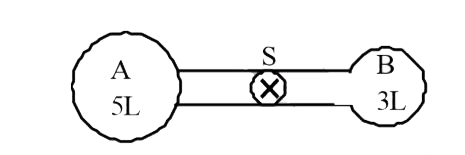A vessel containing 5 litres of a gas at 0.8 m pressure is connected to an evacuated vessel of volume 3 litres. The resultant pressure inside with be (assuming whole system to be isolated)
43m
0.5m
2.0m
34m
The correct Answer is:B
To solve the problem, we will use the concept of the ideal gas law and the principle of conservation of energy in an isolated system. The key idea is that the product of pressure and volume (PV) remains constant before and after the gas expands into the evacuated vessel.
1. Identify Initial Conditions:
- Initial pressure (P1) = 0.8 m (or 0.8 atm)
- Initial volume (V1) = 5 L
- Volume of the evacuated vessel (V2) = 3 L
2. Calculate Total Final Volume:
- The total volume after the gas expands into the evacuated vessel is:
Vtotal=V1+V2=5L+3L=8L
3. Apply the Ideal Gas Law (PV = constant):
- According to the principle of conservation of energy in an isolated system, we have:
P1×V1=P2×Vtotal
- Rearranging the equation to solve for P2 gives:
P2=P1×V1Vtotal
4. Substitute the Known Values:
- Substitute the values into the equation:
P2=0.8m×5L8L
5. Calculate P2:
- Performing the calculation:
P2=4m8=0.5m
6. Conclusion:
- The resultant pressure inside the system after the gas expands into the evacuated vessel is:
P2=0.5m
Final Answer:
The resultant pressure inside the system will be 0.5 m.
---
- Initial pressure (P1) = 0.8 m (or 0.8 atm)
- Initial volume (V1) = 5 L
- Volume of the evacuated vessel (V2) = 3 L
- The total volume after the gas expands into the evacuated vessel is:
Vtotal=V1+V2=5L+3L=8L
- According to the principle of conservation of energy in an isolated system, we have:
P1×V1=P2×Vtotal
- Rearranging the equation to solve for P2 gives:
P2=P1×V1Vtotal
- Substitute the values into the equation:
P2=0.8m×5L8L
- Performing the calculation:
P2=4m8=0.5m
- The resultant pressure inside the system after the gas expands into the evacuated vessel is:
P2=0.5m
The resultant pressure inside the system will be 0.5 m.
Topper's Solved these Questions
Similar Questions
A 8 litre container has gas at 14 atm. Container is connected to another empty vessel of volume 20 litres. Find the pressure exerted by the gas in the new system at constant temperature.
View SolutionA bulb A containing gas at 1.5 bar pressure was connected to an evacuated vessel of 1.0 dm3 capacity through a stopcock. The final pressure of the system dropped to 920 mbar at the same temperature. What is the volume of the container A?
View Solution
Knowledge Check
- Question 1 - Select One
A vessel containing 9 litres of an ideal gas at 760mm pressure is connected to an evacuated 9 litre vessel. The resultant pressure is
A380mmB760mmC190mmD1140mm - Question 2 - Select One
A vessel containing 0.1m3 of air at 76cm of Hg is connected to an evacuated vessel of capacity 0.09m3. The resultant air pressure is:
A20cmofHgB30cmofHgC40cmofHgD60cmofHg - Question 3 - Select One
A vessel contaning 10 litre of air under a pressure of 1MPa is connected to a 4 litre empty vessel. The final air pressure in the vessel assuming that the process is isothermal.
A7/5MPaB5/7MPaC1MPaD10MPa
A bulb 'X' of unknown volume containing a gas at one atmospheric pressure is connected to an evacuated bulb of 0.5 litre capacity through a stop -cock. On opening the stop-cock, the pressure in the whole system after some time was found to have a constant value of 570 mm at the same temperature. What is the volume of the bulb X ?
View SolutionA bulb of unknown volume V contains an ideal gas at 1 atm pressure. This bulb was connected to another evacuated bulb of volume 0.5 litre through a stopcock. When the stopcock was opened the pressure at each became 530 mm while the temperature remained constant. Find V in litres.
View SolutionA vessel A of volume 5 litre has a gas at pressure of 80 cm column of Hg. This is joined to another evacuated vessel B of volume 3 litre. If now the stopcock S is opened and the apprature is maintained at constant temperature then the common pressure will become -
 View Solution
View SolutionA cylinder of 5 L capacity, filled with air at NTP is connected with another evacuated cylinder of 30 L capacity. The resultant air pressure in both the cylinders will be
View SolutionIf 1 litre of a gas A at 600 mm and 0.5 litre of gas B at 800 mm are taken in a 2-litre bulb, the resulting pressure is
View Solution

